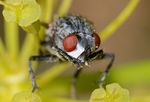Wohlfahrtia spp.
| This article is still under construction. |
| Wohlfahrtia spp. | |
|---|---|
| Kingdom | Animalia |
| Phylum | Arthropoda |
| Class | Insecta |
| Order | Diptera |
| Family | Sarcophagidae |
| Genus | Wohlfahrtia |
Wohlfahritia spp. are from the family Sarcophagidae. Also known as flesh flies; Wohlfahritia are the largest genus, and are known to cause myiasis
W. magnifica
| Also known as: | Flesh Fly
|
Hosts
The females will lay eggs on any warm blooded animal.
Identification
The adults are grey, and have three prominent longitudinal bands. The abdomen has clear black spots.
Life Cycle
W. magnifica are obligate agents of myiasis. The females leave L1 on the host, usually in wounds or body orifices. The larvae then undergo two further moults before leaving the host, and pupating on the ground.
W. nuba
| Also known as: | Flesh Fly |
Hosts
Camels.
Identification
The adults are around 10mm, with long elongated bodies. They have longitudinal black stripes, and a dark grey abdomen.
Life Cycle
The females lay primarily in dead stock, but may also infect live mammals, particularly in Northern Africa, causing myiasis. The females lay L1 on the host, then undergo two further moults, before finally pupating on the ground.
W. vigil
| Also known as: | Grey flesh Fly |
Hosts
Mink, foxes, and rabbits are primarily affected, but W. vigil may also occasionally affect cats and dogs.
Identification
The adults are around 10mm long, with elongated bodies, an longitudinal black stripes. It also has a grey and black abdomen.
Life Cycle
The female leaves active maggots on the host; often in wounds and body orfices. The larvae, however, may penetrate intact skin. The larvae undergo two further transformations, before dropping to the ground to pupate.
W. meigeni
Hosts
Mainly foxes and minks.
Identification
The adults are around 10mm in length, and have slender, elongated bodies. They have longitudinal black stripes and a grey and black abdomen.
Life Cycle
The female lays active maggots on the host, in the orifices or existing areas of myiasis. The larvae then undergo two further moults, then leave the host, and pupate on the ground.
The larvae will be apparent has boil like swellings under the skin.
